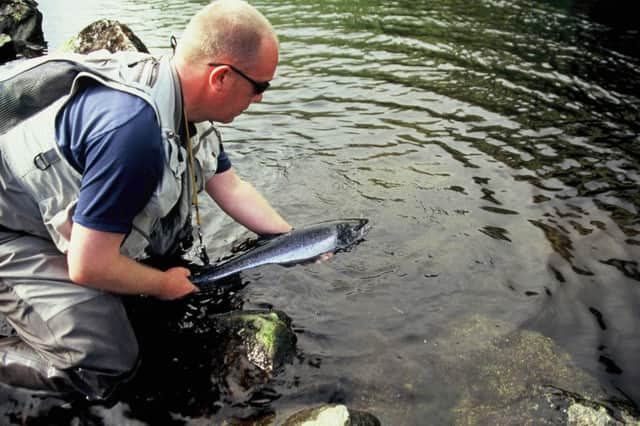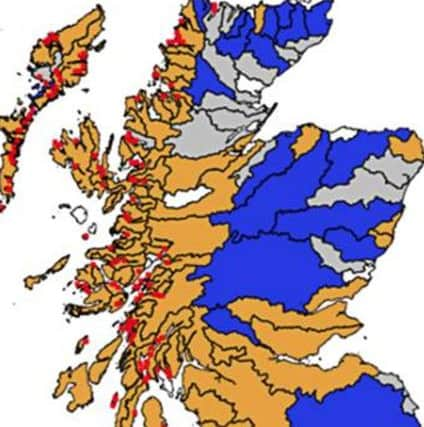Map: Wild salmon dangerously scarce in Highland rivers


Research carried out by Marine Scotland as part of the Scottish Government’s Wild Fisheries Review has graded all salmon grounds in the country.
The results put all rivers in the west Highlands and inner Hebrides, including iconic systems such as the Awe and the Lochy, in the lowest category.
Advertisement
Hide AdAdvertisement
Hide AdThis means wild salmon stocks are not reaching what are known as conservation limits – a measure of the overall health of the population.


The findings confirm numbers are suffering in many places across the country, but reveals the hardest-hit rivers are those in fish-farming zones.
Nearly all the most resilient populations are in the east and north-east.
Conservationists claim the new map represents irrefutable evidence that commercially reared fish are harming their wild counterparts.
Now activists from the charity Salmon and Trout Conservation Scotland (S&TCS) are calling for an immediate ban on further expansion of the aquaculture industry.
The calls fly in the face of government plans to increase farmed salmon by 50 per cent by 2020.
“This new analysis by Marine Scotland should ring alarm bells,” said S&TCS director Andrew Graham-Stewart.
“The fact that no single river within salmon farming’s heartland of the west Highlands and Inner Hebrides has a sufficient stock of wild salmon for any exploitation to be sustainable cannot be a coincidence.
Advertisement
Hide AdAdvertisement
Hide Ad“Regrettably, the Scottish Government has until now habitually down-played studies by third parties, but we believe it cannot ignore its own fisheries scientists’ analysis.
“The contrast between western Scotland and the rest of the country is clear to see, and the only major or substantive distinction between the east and west coasts is, of course, the presence of salmon farming in the west.
“We call on the Scottish Government to halt any further growth in salmon farming until the industry can definitively prove itself to be environmentally sustainable.”
Scotland is currently the largest producer of Atlantic salmon in the EU. Globally, only Norway and Chile produce more. Production in 2012 reached 162,223, estimated to be worth around £537 million. But the government has announced aims to ramp up production over the next five years to exploit demand from China.
Four countries, including Scotland, together support around 90 per cent of the world’s healthy Atlantic salmon populations, but there has been a steady decline in the abundance of salmon in Scottish rivers in recent years. The total catch was about 500,000 in 1975. By 2000 it had plummeted to 100,000 - a drop of 80 per cent in just 25 years.
Almost all UK salmon farms are located in Scotland. The industry has expanded rapidly since the 1970s, with output increasing from 32,000 tonnes in 1990 to 129,000 tonnes in 2000.
Farmed fish are known to impact on wild populations in a number of ways, but parasites and diseases pose the greatest threat. Intensively reared salmon often harbour sea lice, and the highest levels of infestation in wild fish occur in areas used for aquaculture.
Lice feed by grazing on the surface of the fish, eating mucous and skin. Large infestations lead to the loss of fins, severe scarring, secondary infections and eventually death. The fish are literally eaten alive.
Advertisement
Hide AdAdvertisement
Hide AdFisheries experts insist the most harmful fish farming operations should be relocated away from important salmon migration routes as soon as possible, followed by a move to closed containment methods where fish are raised in giant tanks on land.
Roger Brook, chairman of the Argyll District Salmon Fishery Board, said: “On the one hand the Scottish Government is claiming that salmon farming is sustainable, whilst on the other hand it is categorising all wild fisheries in salmon farming areas as unsustainable.
“In light of this new analysis, the Scottish Government should at the very least place a moratorium on any further development or expansion of open-cage marine salmon farms until such time as the likely migration routes of wild salmon are understood. Furthermore, it should now begin a process of relocating farms away from such routes.”
The report of the independent Wild Fisheries Review has recommended ministers take immediate action to conserve wild salmon by introducing a ban on killing the fish, except under licence.
A Scottish Government spokesperson said: “The Scottish Government is working to preserve wild salmon populations, with measures including spring conservation, introduced earlier this year and the proposed salmon kill licence, which would come into operation for the 2016 season.
“Any application for a new salmon farming development requires a detailed assessment of any potential impacts by the relevant local authority.
“We are working with Scotland’s salmon farming industry and representatives of the wild salmon sector on an ambitious programme of research which will explore any potential risk to wild salmon from sea lice, which will help inform Scottish Government policy in relation to supporting both sustainable growth in aquaculture and conserving important wild salmon stocks.”